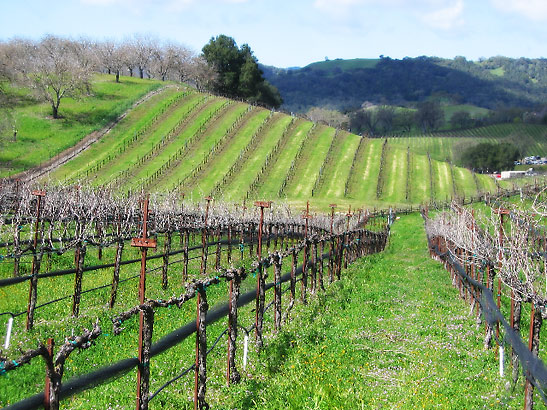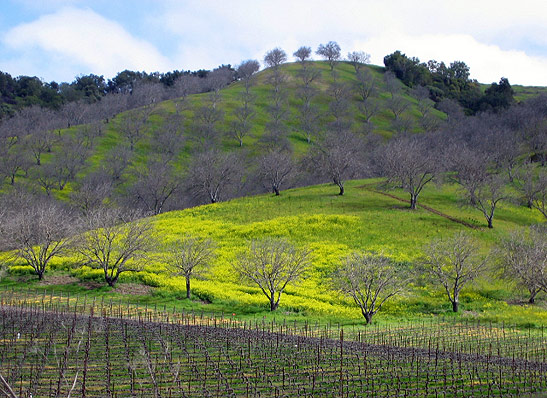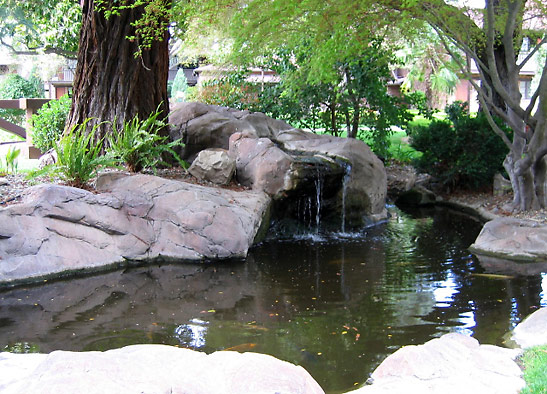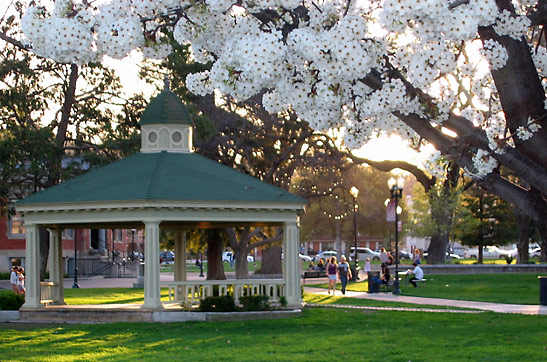 |
 |
|
 |


Take the Cure in Paso Robles
The Pacific Ocean’s salt air and the warm sun flowed in from the coves and bays as my convertible sped toward the Central Coast wine country, lying half way between Los Angeles and San Francisco. A profusion of spring wild flowers, including yellow mustard and orange poppies, sprang from the green rolling hills, newly freshened by the winter rains. I was headed to the 17th Annual Zinfandel Festival, California’s signature grape and America’s contribution to the world of fine wines. Like America itself, the grape is brash, bold and approachable. The likeable wine makes friends quickly, is drinkable within two years of bottling and doesn’t improve with age.
The town of El Paso de Robles (“Pass of the Oaks”) sits behind coastal mountains, lightly dotted by giant California oak trees, growing at respectful distances from each other. The heat of the day draws fog in from the ocean in the late afternoon, crawling over the hills and dramatically cooling the land on a daily basis. (It was 73 degrees on March 20th and 41 degrees that night). A long growing season that can last from bud break in March to harvest in November, also contributes to the spectacular complexity of the wine. The area was once covered by an inland sea, accounting for the calcium-laden rock that characterizes the land. Volcanic activity over the years added lush, red mineral compounds to the mix, which gives the produce and grapes their special flavors. The best tomatoes in California are also born in these soils. Grapes were first brought to the area by Spanish missionaries who needed sacramental wine to conduct mass, but the modern history of El Paso de Robles begins after California was annexed from Mexico in the mid 1800s. It was noticed early on that the hot mineral springs had curative powers. Indian tribes were the first to enjoy the baths, then missionaries, and when the Spanish and Mexicans were kicked out in the mid 1800s, stagecoach routes began stopping in Paso Robles to refresh. In 1861 the first bathhouse was erected and the town soon incorporated. Frank and Jesse James visited in 1867 so Jesse could take the curing sulfur baths and heal his bullet wounds, before going back to their banking careers. With the development of the spa crowd, inns and bathhouses started springing up, most notably the El Paso de Robles Inn. In 1891, after two years of construction and $160,000 in costs, the new inn was one of the most beautiful in America. Unfortunately, like many of the grand resorts, spas and bathhouses built in the 1800s; fire was the main nemesis of these spectacular structures. In 1941 El Paso de Robles met its demise in a raging inferno started by a discarded cigarette. Like other victims, she rose from the ashes, rebuilt as a modern inn, never to regain her former Victorian splendor. But the healing waters of the hot sulfur springs remain at the inn, lending their enduring and discernable aroma to the modern day atmosphere.
With the developing affluence from the tourism and spa trade, Victorian homes were built for the wealthy merchants and landowners. The bucolic City Park with its covered bandstand is at the center of the historic brick and stone faced town. At the turn of the century lovely Craftsman-style bungalows started adding to the Norman Rockwell charm.
Paso Robles remains a friendly country town to this day, despite its spas, festivals and world-class vineyards drawing thousands from around the world. A surprising number of Europeans have also invested in the area, notably winemakers and restaurant owners, bringing a cosmopolitanism blend to the western ambience. In 1914 Polish pianist, populist and former Prime Minister, Ignace Paderewski, visited Paso Robles to take the mineral springs cure for his aching hands, abused by his world concert tour. He found relief in a matter of days and was so enthralled by the town that he continued to visit over the next 30 years, buying two properties, one which he planted with Zinfandel grapes, introduced to the area in 1882. Zinfandel’s origin is most probably the Dalmatian Coast of Croatia and originally came to the United States with Italian wine growers from the southern area of Puglia, Italy in the 1860s. But it is in America where this wine variety made its name. It enjoys a cult following, launching its own fan club (ZAP: Zinfandel Advocates and Producers) and every third week in March, Paso Robles honors the grape with its own festival. This year 52 wineries offered tastings of nearly two hundred wines. They ranged in flavors from delicately balanced Pinot Noir want-a-bes to major flavor bomb show-offs. But there was no mistaking the nose and bold aromas of this true American treasure in all the wines sampled. Some of my favorites were Opolo, David Hunt, Bianchi, Christian Lazo, Eberle, Four Vines, Chateau Margene, Kenneth Volk, RN Estates (which also produces a spectacular late harvest Viognier that has the aroma of bananas), Sextant and Steinbeck. Cindy Steinbeck-Newkirk, a sixth generation Paso Roblean and town historian, conducts the Wine Education Adventure classes at her vineyard. There are 26,000 acres of grapes, 40 varieties and 210 wineries in Paso Robles, most of which have tasting rooms, usually open between 10 a.m. and 5 p.m. daily. The wine country is astonishingly beautiful, especially on the Westside. Most of the vineyards are within a 20 mile radius and easy to find and visit. One of the most beautiful vineyards is Carmody McKnight, situated at the western edge of the appellation in some of the areas richest soils.
The tasting room guards a tree-shaded pond and is surrounded by the vineyard. Owner Gary Conway is a renaissance man. A film and television actor, writer and producer, he is also an internationally recognized artist and his work is featured on the tasting room walls. They also grace his wine bottles and have consistently won the wine label competitions at the Annual California Wine Festival. His wife and co-proprietor Marian is a former Miss America and an excellent chef, and his daughter Kathleen runs the winery. The day I visited their friend Brad Buckley, owner of the nearby Abalone Farm, was barbecuing some of his product. They were buttery, with the texture and taste of refined scallops and perfect with Gary’s minerally chardonnay If You Go: There are many wonderful places to wine and dine in Paso Robles. Some of my favorites were Artisan, whose owner was a manager for the Rolling Stones and Def Leppard, Bistro Laurent for the best French food in town, Thomas Hill Organics, a bistro featuring local produce (and the best tomatoes in California), Panolivo is casual gourmet, Villa Creek for California cuisine and Kaleidoscope Lounge is a comfortable wine bar. There are a number of fine olive oil producers in the area including Gary Conway’s Carmody McKnight Winery, Olio Nuevo, and Pasolivo. We Olive on Park Street is a shop devoted to the product. If you have a sweet tooth don’t miss Powell’s Sweet Shoppe on the corner of City Park. There is a saying in town that it takes a lot of beer to produce a good wine and Firestone Brewery is helping the industry. Tap room opens from Noon to 7 p.m. daily. For a good pint visit the Crooked Kilt on Park Street. Accommodations range from chain motels to bed & breakfasts, country inns and luxury hotels. I stayed at La Bellasera Hotel & Suites, a Tuscan styled facility with a restaurant devoted to wine pairings (Enoteca) and a spa. For guided tours The WineYard Tour will take you into the heart of wine country and Wine Wrangler will take you to the tasting rooms as your designated driver. There are two other major wine festivals, held the third weekends of May and October, and the monthly Central Coast Magazine is a good source for activities. For information on tasting rooms and wineries contact the Paso Robles Wine Country Alliance. For information on Paso Robles, accommodations, restaurants, festivals, tours, etc. Related Articles: |
|
Feedback for South of the Border Wine Country Hello John – I enjoyed reading your article. I live in
La Bufadora and have friends visiting next week, so you have given me some good
tips on where to go in our wine country. We have always called Cetto –
L.A. (like Los Angeles) Chet-o and it might have been worth mentioning that
it is actually Italian in origin. Also, I don't know about when visiting the
Valle, but when in town, it is better to have pesos than dollars. Right now
the rate is approx. 11.70 for each dollar. Just sayin' and like I said good
article!
Hi, We here at Country Living Magazine are working on a story about hotels around the US. We would like to feature the Paso Robles Inn. I have to find photos to go along with the story. I was wondering if you could please send me any images of the hotel. This can be anything from the rooms to the food! All images can be submitted low res and if selected I will ask for hi rez later. Also, if you know of any photographers that have photographed the hotel can you please give me the contact info? Thank you so much! --- Will Morel, Assistant Photo Editor, Country Living Magazine, New York, NY
I am looking forward to my "silver" years, which in my case, will be the years (if fate is good to me) that I will finally be traveling. New Zealand is at the top of the list - I have always been drawn to it. --- Sandra Mines, Seattle, WA
Yes, was a fun city. Bad wine though. --- Bo, Portland, OR
|
This site is designed and maintained by WYNK Marketing. Send all technical issues to: support@wynkmarketing.com

|















